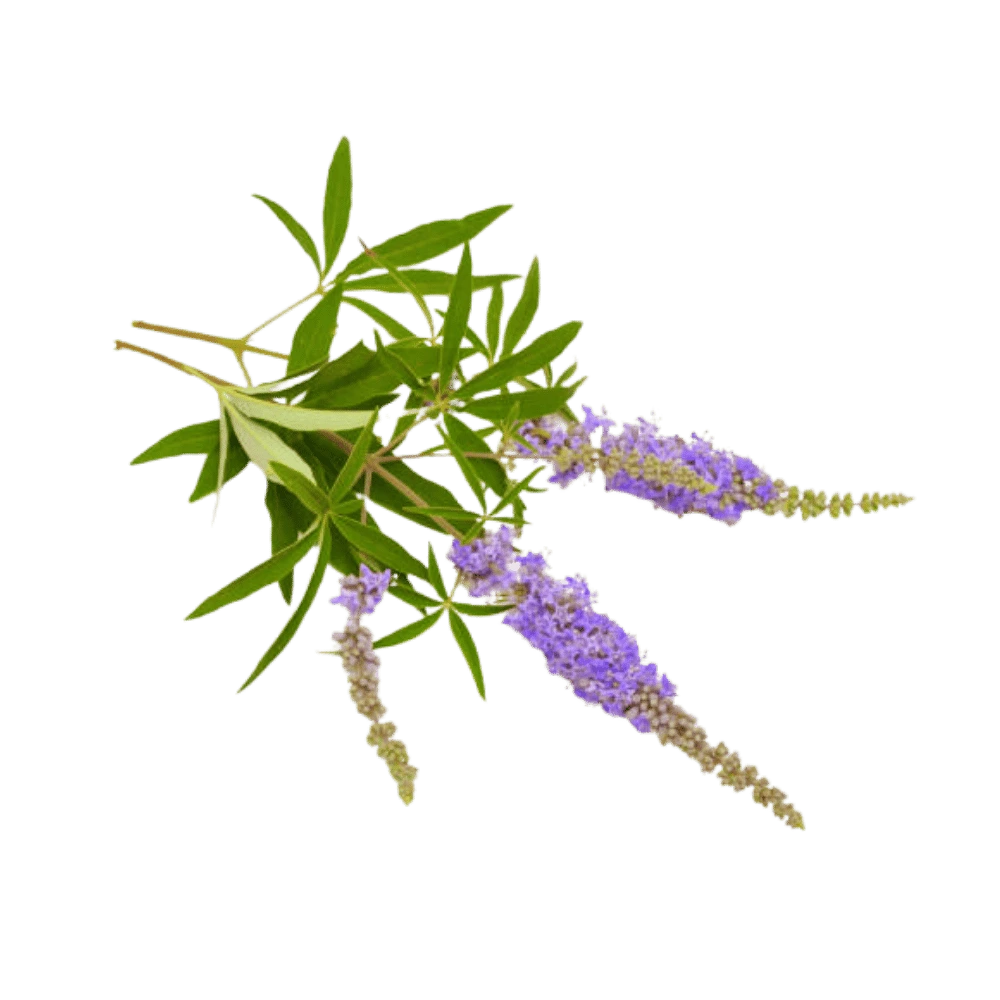
Chasteberry
Chasteberry, derived from the Vitex agnus-castus plant, alleviates menopausal symptoms by influencing hormonal balance. Research suggests that it acts on the pituitary gland, promoting an increase in luteinizing hormone and a subsequent adjustment in estrogen and progesterone levels.
-

Skin Health
-

Weight Management
-

Heart Health
-

Immunity Boosting
-

Lung Health
Collapsible content
References
van Die MD, Burger HG, Teede HJ, Bone KM. Vitex agnus-castus Extracts for Female Reproductive Disorders: A Systematic Review of Clinical Trials. Planta Med. 2013;79(7):562-575. doi:10.1055/s-0032-1327831.
Publication Date: "Published by Georg Thieme Verlag KG Stuttgart · New York, no specific publication date mentioned in text."
Peer Reviewed: Yes
Study Design: "randomized, controlled trials"
Methodology: Randomized controlled trials evaluating Vitex versus placebo, fluoxetine, pyridoxine, magnesium, or bromocriptine for PMS, PMDD, or latent hyperprolactinaemia in women. Sample sizes ranged from 52 to 208 participants. Multiple Vitex preparations were used.
Sample Size: "estimates ranged from 55 to 120 patients per arm, allowing for drop-outs and withdrawals."
Controls Used: "placebo-controlled," "comparator studies with pyridoxine and magnesium," "comparator studies with fluoxetine and bromocriptine."
Dose Used: "Doses ranged from 20 to 1800 mg/day, with the most commonly prescribed dose being 40 mg/day dried fruit equivalent."
Statistical Significance Declared: "Vitex was superior to placebo for total PMS symptoms (p < 0.001)." "Fluoxetine outperformed Vitex for PMDD (p < 0.02)."
Adverse Events: "Adverse events associated with Vitex were mild and included headaches, skin reactions, gastrointestinal complaints, and acne."
Conflict of Interest: "Associate Prof. Kerry Bone is a founder and director of research and development of MediHerb Australia Pty. Ltd."
Schellenberg R. Treatment for the premenstrual syndrome with agnus castus fruit extract: prospective, randomised, placebo controlled study. BMJ. 2001;322(7279):134-137. doi:10.1136/bmj.322.7279.134.
Publication Date: "BMJ. 2001 Jan 20."
Peer Reviewed: Yes
Study Design: "Randomised, double blind, placebo controlled, parallel group comparison."
Methodology: Randomized, double-blind, placebo-controlled trial with 170 women over three menstrual cycles using a dry extract of Vitex agnus-castus or placebo, assessing symptoms like irritability, mood alteration, and headache using visual analogue scales.
Sample Size: "178 women were screened and 170 were evaluated (active 86; placebo 84)."
Controls Used: "Placebo-controlled."
Dose Used: "One 20 mg tablet once daily."
Statistical Significance Declared: "Improvement in the main variable was greater in the active group compared with placebo group (P<0.001)." "Significant (P<0.001) superiority of active treatment in each of the three global impression items."
Adverse Events: "Seven women reported mild adverse events (four active; three placebo), none of which caused discontinuation of treatment." "Adverse events reported included acne, multiple abscesses, intermenstrual bleeding, and urticaria."
Conflict of Interest: "None declared."
Wuttke W, Jarry H, Christoffel V, Spengler B, Seidlová-Wuttke D. Chaste tree (Vitex agnus-castus)—pharmacology and clinical indications. Phytomedicine. 2003;10(4):348-357. doi:10.1078/094471103322004866.
Publication Date: "Available online 10 November 2004."
Peer Reviewed: Yes
Study Design: "Double-blind placebo-controlled clinical study."
Methodology: Double-blind, placebo-controlled studies on premenstrual mastodynia and other premenstrual symptoms. Dopaminergic compounds were identified and tested for prolactin-suppressive effects.
Sample Size: Not explicitly mentioned in this specific section.
Controls Used: "Placebo-controlled."
Dose Used: "BNO 1095 (a 70% ethanol, 30% H2O extract)."
Statistical Significance Declared: "Asterisks indicate P < 0.05."
Adverse Events: Not explicitly mentioned in this specific section.
Conflict of Interest: "This work is in part funded by an EU grant (EUROSTERONE – QLRT-1990-00762) and by the German Research Society."
Carmichael AR. Can Vitex Agnus Castus be Used for the Treatment of Mastalgia? What is the Current Evidence? Evid Based Complement Alternat Med. 2008;5(3):247-250. doi:10.1093/ecam/nem074.
Publication Date: "Published online 2007 Nov 17."
Peer Reviewed: Yes
Study Design: "Randomized, double-blind, placebo-controlled trial."
Methodology: Data from randomized and non-randomized studies regarding the efficacy and safety of A. castus were reviewed. A. castus was tested for its prolactin-suppressive effects in laboratory and clinical studies on patients suffering from cyclical mastalgia.
Sample Size: "A randomized, double-blind, placebo controlled trial... was carried out in 170 women."
Controls Used: "Placebo-controlled."
Dose Used: Not explicitly mentioned in this section.
Statistical Significance Declared: "Improvement in breast pain was greater in the A. castus group compared with placebo group (52% versus 24%, P < 0.001)."
Adverse Events: "The most frequent adverse events... nausea, headache, gastrointestinal disturbances, menstrual disorders, acne, pruritus and erythematous rash."
Conflict of Interest: Not explicitly mentioned in this section.
Cerqueira RO, Frey BN, Leclerc E, Brietzke E. Vitex agnus castus for premenstrual syndrome and premenstrual dysphoric disorder: a systematic review. Arch Womens Ment Health. 2017;20(6):713-719. doi:10.1007/s00737-017-0791-0.
Publication Date: "Published: 23 October 2017."
Peer Reviewed: Yes
Study Design: "A systematic review of randomized controlled trials (RCTs)."
Methodology: A systematic review of eight RCTs using VAC for PMS/PMDD, comparing VAC to placebo or active treatments over several menstrual cycles, with self-reported symptom scoring.
Sample Size: "Schellenberg (2001) enrolled 178 women with PMS."
Controls Used: "Placebo-controlled."
Dose Used: "Tablets containing fruit extract Ze 440, with dosages of 8, 20, and 30 mg."
Statistical Significance Declared: "VAC significantly reduced PMS symptoms compared to placebo (p < 0.001)."
Adverse Events: "Four patients in the VAC group reported acne, multiple abscesses, intermenstrual bleeding, and urticaria."
Conflict of Interest: Not mentioned explicitly in this section.
Lucks BC. Vitex agnus castus essential oil and menopausal balance: a research update. Complement Ther Nurs Midwifery. 2003;9(3):157-160. doi:10.1016/S1353-6117(03)00020-9.
Publication Date: "Available online 3 July 2003."
Peer Reviewed: Yes
Study Design: "Surveys completed by 52 participants monitored by 12 diverse health practitioners."
Methodology: Participants used a 1.5% solution of essential oil in a cream base, applied dermally for 5-7 days per week for 3 months. Surveys recorded symptom relief and side effects.
Sample Size: "52 trial participants."
Controls Used: "Placebo control was not possible."
Dose Used: "1.5% solution of the essential oil applied dermally, 2.5 ml of cream daily."
Statistical Significance Declared: Not explicitly mentioned in the study.
Adverse Events: "Six subjects reported emotional decline, five reported increased bleeding, three reported increased hot flashes/night sweats, and nausea."
Conflict of Interest: Not explicitly mentioned in this section.





